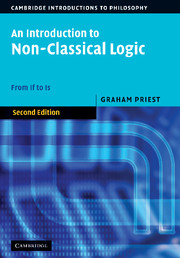Book contents
- Frontmatter
- Contents
- Preface to the First Edition
- Preface to the Second Edition
- Mathematical Prolegomenon
- Part I Propositional Logic
- Part II Quantification and Identity
- 12 Classical First-order Logic
- 13 Free Logics
- 14 Constant Domain Modal Logics
- 15 Variable Domain Modal Logics
- 16 Necessary Identity in Modal Logic
- 17 Contingent Identity in Modal Logic
- 18 Non-normal Modal Logics
- 19 Conditional Logics
- 20 Intuitionist Logic
- 21 Many-valued Logics
- 22 First Degree Entailment
- 23 Logics with Gaps, Gluts and Worlds
- 24 Relevant Logics
- 25 Fuzzy Logics
- Postscript: A Methodological Coda
- References
- Index of Names
- Index of Subjects
25 - Fuzzy Logics
Published online by Cambridge University Press: 05 June 2012
- Frontmatter
- Contents
- Preface to the First Edition
- Preface to the Second Edition
- Mathematical Prolegomenon
- Part I Propositional Logic
- Part II Quantification and Identity
- 12 Classical First-order Logic
- 13 Free Logics
- 14 Constant Domain Modal Logics
- 15 Variable Domain Modal Logics
- 16 Necessary Identity in Modal Logic
- 17 Contingent Identity in Modal Logic
- 18 Non-normal Modal Logics
- 19 Conditional Logics
- 20 Intuitionist Logic
- 21 Many-valued Logics
- 22 First Degree Entailment
- 23 Logics with Gaps, Gluts and Worlds
- 24 Relevant Logics
- 25 Fuzzy Logics
- Postscript: A Methodological Coda
- References
- Index of Names
- Index of Subjects
Summary
Introduction
25.1.1 In this chapter, we will look at the addition of quantifiers to the Łukasiewicz continuum-valued logic.
25.1.2 We will then look at the behaviour of identity in this logic.
25.1.3 This will occasion a discussion of some philosophical issues concerning fuzzy identity, connected, in particular, with the sorites paradox and with vague objects.
25.1.4 A technical appendix describes the addition of quantifiers and identity to the general class of t-norm logics.
Quantified Łukasiewicz Logic
25.2.1 In the language we are concerned with, the set of connectives, C, is {∧, ∨, ¬, →}, and the set of quantifiers, Q, is {∀, ∃}. (A ↔ B can be taken as defined as (A → B) ∧ (B → A).)
25.2.2 As we saw in 21.2, an interpretation for a quantified many-valued logic is a structure 〈D, V, D, {fc : c ∈ C}, {fq : q ∈ Q}, ν〉. D is a non-empty domain of quantification. For every constant, c, ν(c) ∈ D, and for every n-place predicate, P, ν(P) is an n-place function that maps members of D into the truth values, V. In Łukasiewicz continuum-valued logic, V = [0, 1], the set of real numbers between 0 and 1, ordered in the usual way. f∨, f∧, f¬ and f→ are as in the propositional case (11.4.2).
- Type
- Chapter
- Information
- An Introduction to Non-Classical LogicFrom If to Is, pp. 564 - 583Publisher: Cambridge University PressPrint publication year: 2008



